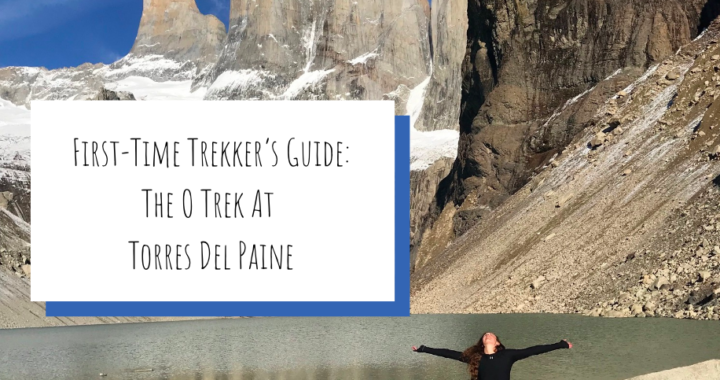Hey friends! Greetings from South America! I’ve been here for about a month and a half and I can’t wait to share some of my stories from Chile and Argentina. So let’s start off with info about the highlight of my trip: The O Trek at Torres Del Paine!
One of my goals for this trip was to complete my first multi-day hike: the O circuit at Torres Del Paine. I am not a hiker, so this was quite an undertaking.
The O circuit (also known as the O trek) is the longest trek around Torres Del Paine National Park in Chile. It takes about eight days, but in a possible fit of delusion, I accepted the challenge that no one bestowed upon me and booked my campsites.
Immediately, I started asking myself,
Can You Do The O Trek As a First-Time Trekker?
Luckily, I figured out the answer is “yes.” With proper preparation, a great attitude, and the right gear, the O trek is a rewarding, eye-opening, and doable multi-day hike. Solo hikers, first-time trekkers, and veterans alike should consider crossing this trek off their list.
Here’s all of the information I wish I had when I booked the trek.
What Is The O Trek?
When you plan a trip to Torres Del Paine, you have a lot of options. You can do day hikes to the Torres (aka, the Towers in everyone’s Instagrams,) the W trek, or the O trek. There are even more options to explore, but most backpackers choose one of the three.
Day hikes are a day or two long, surprise. The W trek is around four days long; it goes from Paine Grande to Central and still includes the beautiful towers. The O trek goes from Central to Central or Paine Grande to Paine Grande (although most people choose the first option.)
Here’s why I chose the O trek: go big or go home. A lot of blogs said that if you are going to do the W, you might as well do the O. You get to cross the John Gardner pass (the highest point of the circuit, but with the most awe-inspiring views on the trek,) and can enjoy some alone time with nature before you hit 20-person tour groups that slow you down on the W trek. Not to be a jerk, but the solitude is nice.
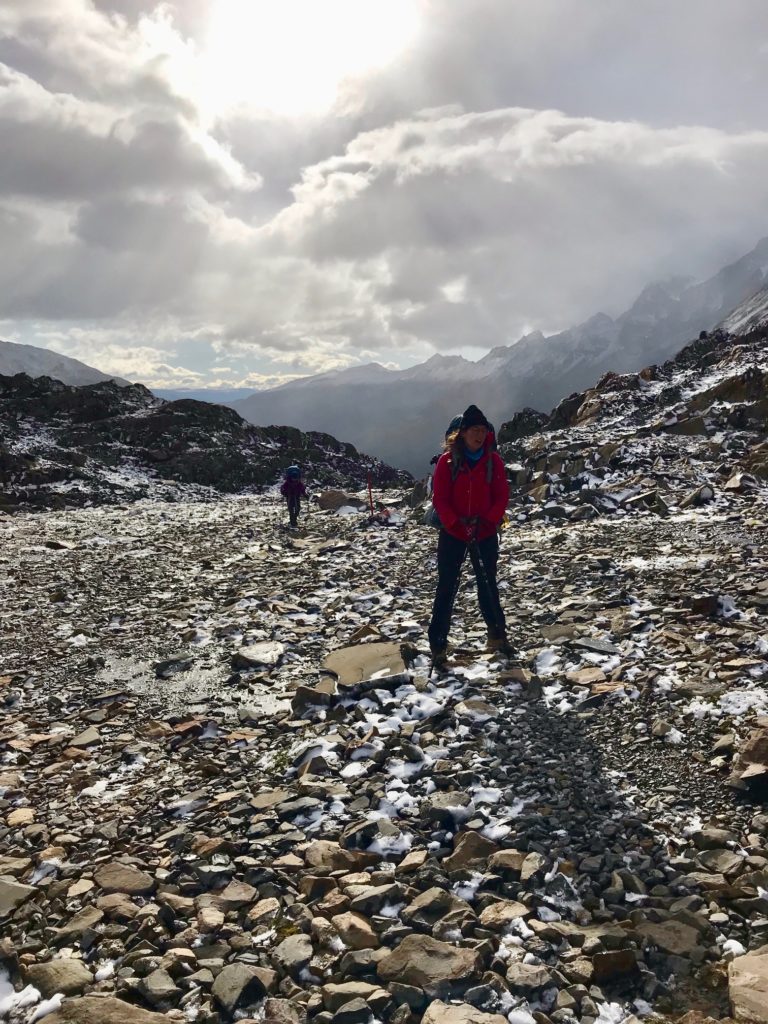
Don’t ask me what is going on with my face, but this is just a little photo from the John Gardner pass.
How Long Does the O Trek Take?
It takes about eight days. Some have done it in as little as five, but if you’re a first-time trekker, don’t get all Adventure Allen on me and try and go for six. If you have a lot of time, you can do it in 10 days, but you’ll need to book all of your campsites ahead of time.
How Do You Book Campsites on the O Trek?
This is honestly the most frustrating part of the O trek. Trekkers will need to book online through two or three different companies: Vertice, Fantastico Sur, and CONAF. Give yourself at least three months to book your campsites, especially if you’re going during the busy season (January-March.) This gets frustrating because the websites are honestly terrible, but maybe by the time you read this, they’ll be a bit more user-friendly.
When you book, you can also book food and gear. That’s right. If you want, you can book three square meals, a tent, a sleeping bag, and a sleeping pad at (most of) the campsites. It’s expensive, but if you aren’t a Beat, Broke, Backpacker, you can have a darn cushy experience.
I booked two box lunches and a dinner, just to treat myself. They were expensive ($20-$25 USD,) but the dinner was delicious. At Dickson, they even had a vegetarian option! I had a soup, quiche, and rice pudding. By the end, I was stuffed, and it made the walk to Perros even easier.
What Are the Campsites at Torres Del Paine Like?
Comfortable! Trekkers can enjoy a hot shower at most of the campsites, wifi at a few, and the chance to splurge on a bed. First-time trekkers should pack accordingly, but if you forget fuel or run out of food, you can usually buy it at each campsite minimarket.
If you get thirsty, all of the streams are drinkable! All of them! Even on the trails! Whoohoo!
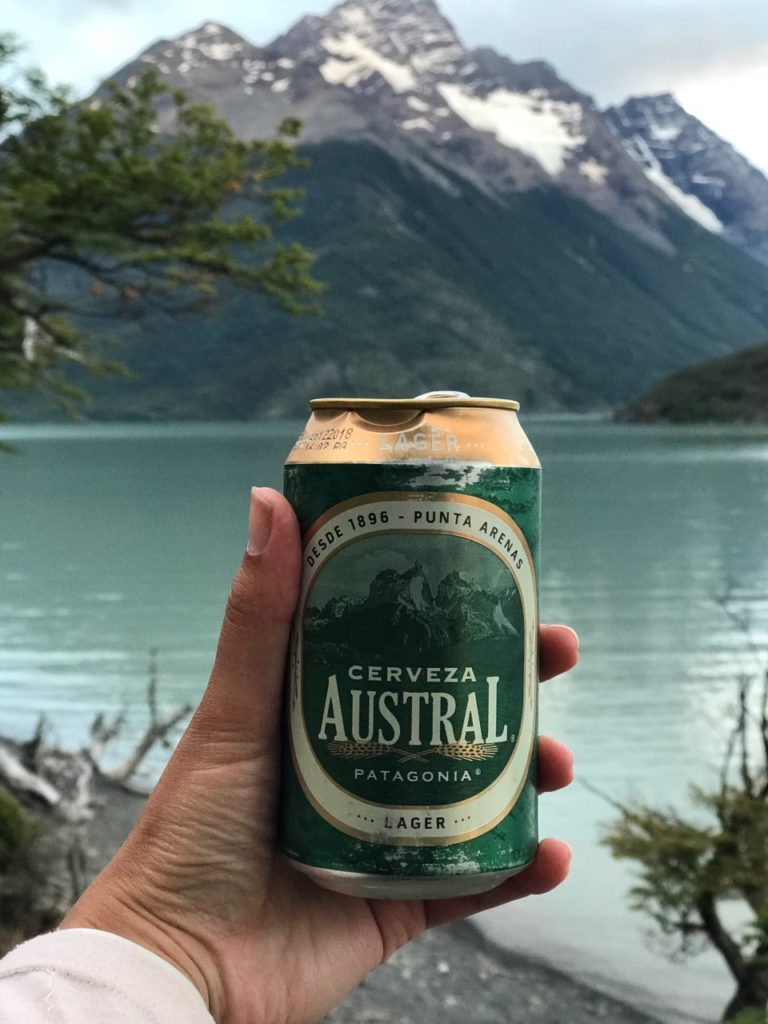
You can also purchase beer at most of the campsites for 4000-5000 CLP. This is a photo from the Dickson campsite. Cheers!
How Difficult Are the Hikes On The O Trek?
They’re all doable. Some days are harder than others; the trek up to the John Gardner Pass and the trek up to the Torres are going to be the hardest parts of the journey. But if you bring hiking poles and don’t push yourself to complete more than two hikes each day, you’ll be fine.
Also, the hike is super well-marked. You literally cannot get lost. While not all paths are flat, you can at least identify where you’re stepping next with ease. Things only get tricky right before the pass and right before the towers.
Backpacker Steve has a more detailed and helpful set of itineraries, but here is the itinerary that I chose:
Day One: Torres – Seron (3 ½ hours)
Day Two: Seron – Dickson (5 hours)
Day Three: Dickson – Perros (3 hours)
Day Four: Perros – Pasos – Grey (6 hours + 3 ½ hours)
Day Five: Grey – Paine Grande (4 hours)
Day Six: Paine Grande – Italiano – Frances (3 hours. At Italiano you can also spend a few hours hiking up to the Mirador Britanico. I spent about two hours hiking ⅓ of it, but my knees were screaming, and I wanted to rest up for the hike up to the Torres on Day 8.)
Day Seven: Frances – Central (6 hours)
Day Eight: Central – Torres – Central (8 hours)
Whoohoo! When I realized that each day wasn’t going to be eight hours of hiking, I felt more confident about the hike. The easy days are easy, but I’m not going to lie…Day Four and Day Eight were doozies. I packed about 15-25 pounds worth of stuff on my back, too.
Quick Disclosure:
I’m a decently fit human, brought good gear, and had amazing weather most days on the O trek. I certainly didn’t train for the hike, and my knees started hurting after my trek from Perros-Grey, but I got through the whole endeavor without major booboos. I did cry for less than 30 minutes when my tent broke, and may have had a tiny little meltdown on the four-hour hike up to the Towers, but still had an amazing experience. Lot to unpack there, but good to know for hikers in a similar situation.
Wait, Your Tent Broke?
You read the disclosure! So, yes, my tent broke at Paine Grande. It put the broke in Beat, Broke, Backpacking, you know what I mean?
If you want to worry about one thing at Torres Del Paine, it should be the weather. I had amazing weather for the O trek (clear skies, rain only at night, and fairly calm winds everywhere outside of Grey and Paine Grande,) but that’s not always the case. 100mph winds. Crazy rain. Pack covers and tents and backpacks flying everywhere. It all happens.
I brought a one-person tent that is held up by two sets of connected poles. (I wanted something light because I was worried about how much weight I was carrying.) At Paine Grande, I put it up in a pretty terrible spot and within an hour, the wind snapped the bottom pole in half. That bottom pole made a little rip in the fly – not a huge one, but enough to send me into a panic as I watched the tent flatten each way from the wind. A guy who worked at the campsite gave me a tent splint and advised that I restring the bottom pole so it was separate from the top. I did, but there wasn’t duct tape in sight and the tent was still wildin’ out in the wind.
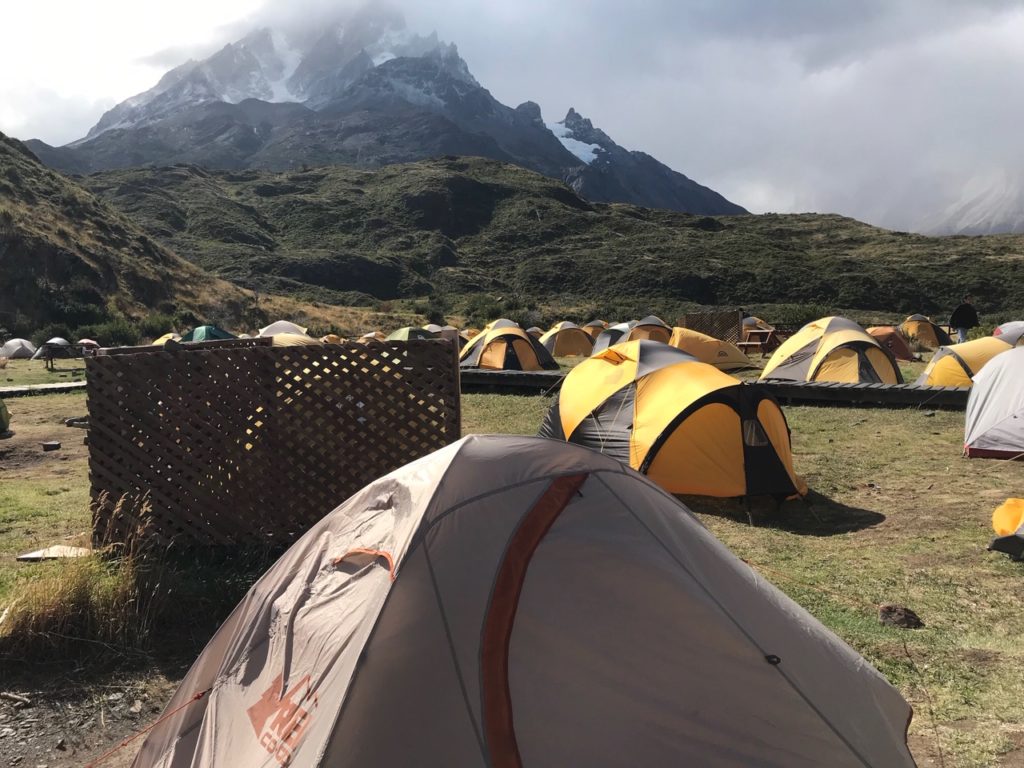
It looks calm at Paine Grande…but it…wasn’t.
At 11 p.m., I decided that nature had won this time. I ran into the camping office (which was surprisingly open,) and asked if I could crash in the office for the night. Instead, they offered to let me rent one of the empty tents that were already set up. I said, hell yeah, and then cringed/giggled as the employee peeked into like, all of the tents to find an empty one. He found one, I slipped him 10000 CLP, and literally threw my entire tent and its contents into it.
But I Fixed It!
The next night at Frances, I rented a tent for 20000 CLP. That’s a pretty penny, and in the wind-less night, I wondered if my tent could have stood up in the weather and saved me some cash.
So the next night (and my last on the trek,) I asked for a tent at Central. The guy at the camping office said he wouldn’t know for two hours if one was open. I replied, “Eh, I either need a tent or some duct tape,” and like Prince Charming presenting Cinderella her glass slipper, the guy gave me some duct tape. (He was cute too.) I had already added the splint to my pole, so I just duct taped the rip in the fly and put up my tent like normal. It worked! It held up all night and I was immensely proud. Never learned the guy at the camping office’s name, but I accidentally stole his pen, so…
But Overall, It Was a Great Hike?
YES! I’m very glad I got to check this item off of my bucket list and prove to myself that I had the physical/mental capacity to do an eight-day hike. Again, I was #blessed with amazing weather, so that might have made a huge difference.
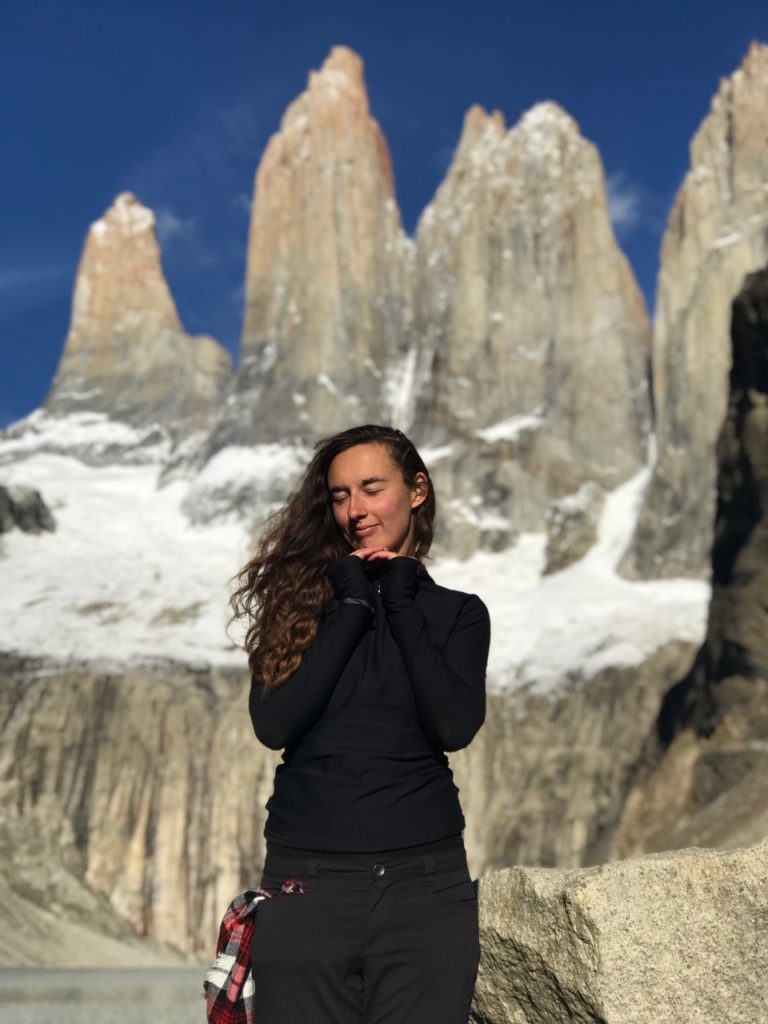
Happy human at the towers. Not going to lie, wasn’t so happy about a half an hour before the photo was taken, but just look at that view!
The Importance of a Good Attitude
My determination to be a literal happy camper also carried me through some of the tougher portions of the hike. No more than a few hours into the hike, I (and most people at the campsite) heard a group of Americans who were clearly having a rough go of things.
They planned to do the hike super fast, even though it was definitely at least one of their first hikes. They got stopped along the way and were going to miss their flights home. Despite the fact that they couldn’t really change anything, they were pouting very loudly. (As Americans tend to do.) Some fellow campers giggled at their passive-aggressive comments toward each other, and others cringed at their bad mood. It reminded me at how useless a bad attitude can be in situations that you can’t change. And the importance of a good attitude at TDP is one of the first things mentioned at Erratic Rock.
Last Tips About the O Trek At Torres Del Paine
What rock?
So, if you still want more information about Torres Del Paine, be sure to hit up the 3 o’clock talks at Erratic Rock. It’s a hostel in Puerto Natales and they do this talk every day. I highly recommend it, the guy was fun, he knows the park really well, and the hostel has a free bin and tent repair station. (Wrap some duct tape around your water bottle so you don’t end up scrounging for duct tape like me.)
I’m publishing a packing list on what to pack, so look out for that.
I’m also going to publish a list of places to stay in Puerto Natales. I booked a hostel for the night that I got back to Puerto Natales and then a fancy hotel the next day to unwind and catch up on Drag Race. Give yourself a buffer day just in case you do get stopped along the way. If you’re pacing yourself, that shouldn’t happen, but you never know.
Phew. I think that’s about it! Feel free to leave some questions in the comments if you’re doing the O circuit as a first-time trekker. Have fun and enjoy!
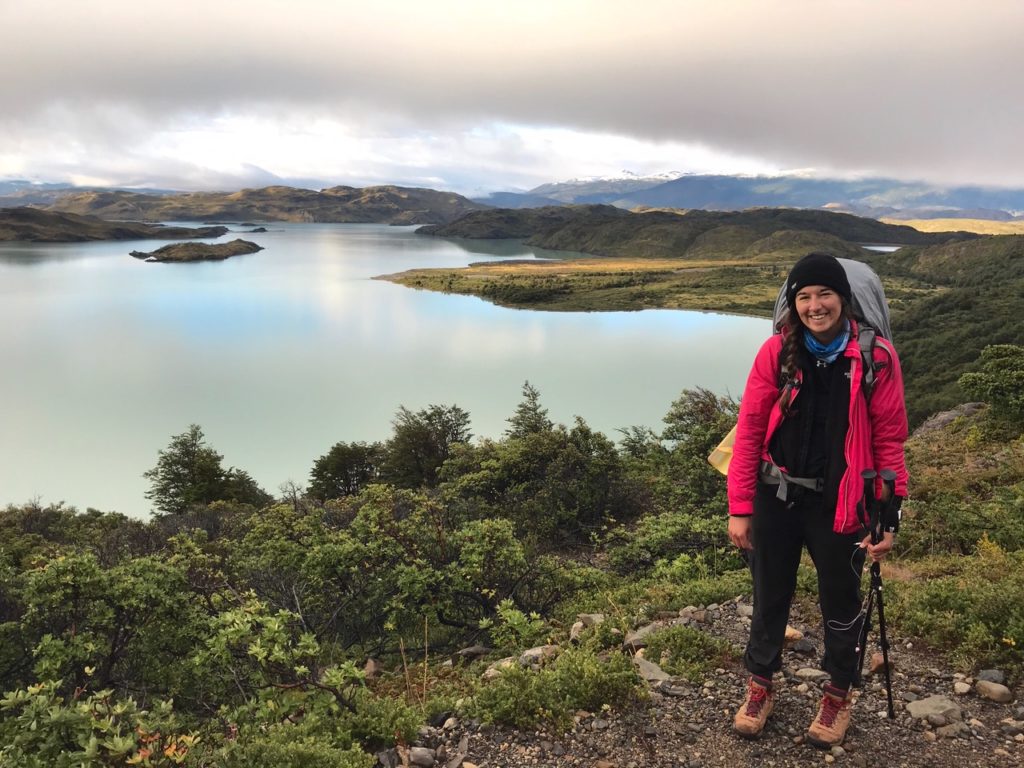
Bonus photo: all smiles on the hike between Italiano and Frances.
